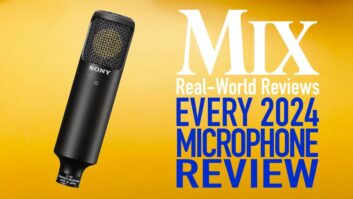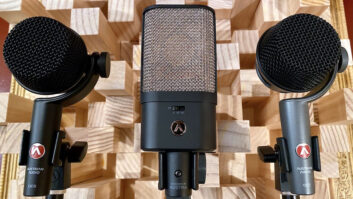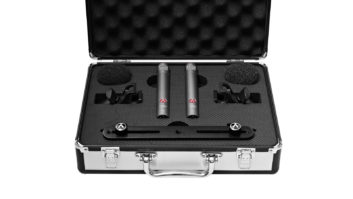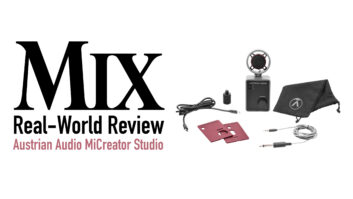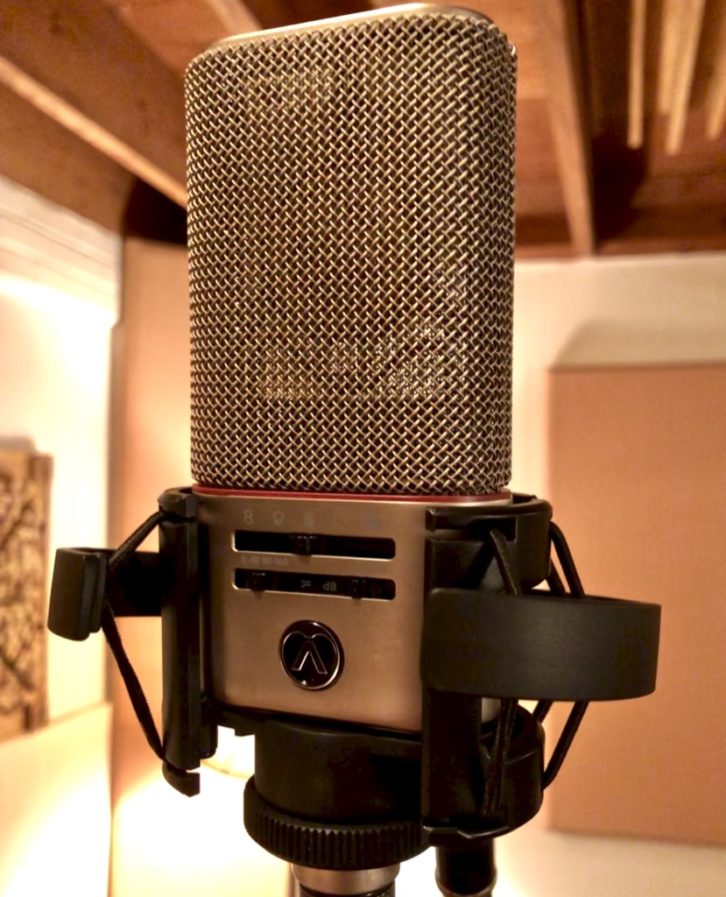
While plug-ins seem to gather most of the “revolutionary new product” excitement, a team of 20-plus ex-AKG engineers has formed Austrian Audio and put out a new microphone that combines the best of the old with a healthy dose of some extraordinary new features.
Out of the Box
With a small, flat, rectangular body somewhat reminiscent of a C414, and a capsule (Austrian’s handmade CKR12) made with similar dimensions, not to mention properties similar to a CK12 capsule, comparisons to the AKG classic are certainly founded. The similarities continue with multiple polar patterns (cardioid, omnidirectional, figure 8, hypercardioid), two levels of defeatable padding/attenuation (-10 and -20 dB) and three levels of defeatable highpass filtering (40, 80 and 160 Hz). A major difference, however, is the ceramic capsule housing that contains the dual diaphragms. Ceramics are low in resonance, insensitive to temperature changes and quite stable, contributing to the consistent performance of the diaphragm. Such consistency is achieved that Austrian Audio boasts that all OC818s are close enough in performance to be a matched pair, and that in cardioid mode, any OC818 microphone is also a match for any other OC18 microphone (the OC818’s single-pattern little brother).
Beyond construction and materials, what really sets the 818 apart are its futuristic electronics, which include dual outputs, wireless remote control and post-production flexibility.
PreSonus Eris E8XT Studio Monitors Review
Pliant CrewCom Professional Wireless Intercom – A Real-World Review
Ultimate Ears Fitkit, 18+ CSX IEM – A Real-World Review
Via a small LEMO connector on the rear of the mic (and a supplied short LEMO-to-XLR-M cable), each diaphragm of the 818 can be output separately, allowing astute engineers to combine the two signals and manipulate their polarity and gain for various polar patterns—or simply use the free PolarDesigner open source plug-in (VST, AAX, AU with Windows or Mac) to do the dirty work for you. Deep control is provided via one to five crossover bands with selectable crossover points, band solo/mute, full automation, EQ for dialed-in free or diffuse field response, proximity effect control, store/recall/share of presets and phase linear operation.
That same LEMO connector can conversely be connected to the optional OCR8 Bluetooth dongle, and with the mic’s polar pattern set in the “black circle” position, wireless control is achieved via the free PolarPilot application (Android or iOS). Real-time control is provided with the ability to create as many as 255 discrete polar patterns, save/recall/share settings, a 60-second overload/clipping monitor and logger, and storing of the last setting used within the 818, even without the PolarPilot app. This is all done with only microprocessor control of bias voltages. The actual signal path remains purely analog; there is no use of digital signal processing or conversion.
The kit is completed with an aluminum carrying case, a largely plastic (yet sturdy) shock mount, foam windscreen and standard mic stand mount.
In Session
Naturally, I started testing without any apps or wireless control, with cardioid usage on vocals, drum room, tambourine, cajón and acoustic guitar. Yes, I realize those are radically divergent sources, but I grouped them all together, as the 818 showed no difference in its response. About as neutral as a large-diaphragm condenser mic can be, the 818 always provided seemingly perfectly flat response, regardless of sound pressure level, placement or frequency content. Vocals (in cardioid with no pad and 40 Hz HPF) were completely un-hyped and natural, absent of excessive resonance, sibilance, mouth noises (i.e. clicks, pops), chestiness, high-mid frequency emphasis or excessive proximity effect. Drums (cardioid or omni, -10 dB pad or up full) showed only minimal cymbal preference (likely created by my room), an extended bottom end and very natural dynamics. Instruments, including tambo, lacked harshness, translated accurately and sounded just like being there. The 818 lacked the depth of a ribbon mounted low on my cajón and lacked the snap of a crispy condenser when mounted high, but with a neutrality that many engineers might just prefer for either position. Off-axis pickup was smoother than typical for an LDC.
At times, I found the OC818 microphone to be a little too neutral for vocal work, but the super-cardioid pattern brought a little more excitement and presence, as well as directional focus to my vox. The highpass filtering proved its mettle here too, with the second-order filters at 40 and 80 Hz being obviously useful, but the multi-order 160 Hz position (first order gently down to 80, a steep second order below) being nicely sloped and helpful for seriously thinning out backup vocal stacks.
Figure-eight patterns found the OC818 sounding more neutral and similar to its cardioid pattern than typical. For classic fig-eight apps like two-person harmony vocals, dual handclaps and drum room, you’ll find airy naturalism, balanced frequency response and nice null rejection.
PolarDesigner offers some seriously advanced uses for those who want deep control. I tracked some drum roomage using the supplied LEMO-to-XLR-M connector and sent both diaphragms to a stereo track. I then applied PolarDesigner and found a world of options. Changing the polar patterns was easy enough and quite useful, but having five bandwidths and allowing each to have its own directional property was more than I could find use for, considering my need and habit of working quickly. Basically, I found one full-frequency band of control sufficient. What I did find very useful was the proximity effect control; you can boost or cut it variably, and a little careful boost brought some very nice low-end girth and boom to my drum room. For those tracking either dialogue or Foley for film production, this app’s advanced control could be extremely useful, even if it may be a bit much for standard music production or those with shorter attention spans.
If you don’t need to track both diaphragms, then you can insert the OCR8 Bluetooth dongle into that same LEMO connector and enjoy some remote control via PolarPilot. Being able to change patterns, filters and pads remotely while seated right in the monitoring sweet spot obviously has its attractions, but I found myself at a distance of 35 feet plus, just barely outside the operating range of the current Bluetooth standard. (The newly announced standard will increase that range.) Unfortunately, my iPhone 8 Plus couldn’t manage to stay connected with the app even at close distances, with skittish performance and dropouts. What I did manage to do was quite useful, though; I set the 818 for a wide cardioid pattern, with no pad and the 80 Hz HPF, and enjoyed my very favorite setting for vocal work. With this setting stored in the 818, I could recall it when needed, even without the app. I hope that Austrian Audio can work the bugs out of the OCR8 dongle, as the app’s functionality could be a major benefit.
The Final Mix
Considering the incredible versatility of the OC818 microphone, the quality kit, the post-production flexibility and PolarPilot’s utility (even if hampered by quirks and distance), the 818 is an easy recommendation at a very reasonable $999. Easy stereo-pairing with other 818s and the OCR18 is another big plus that makes these mics a great choice for live show “tapers,” recording ambiences and classical recordists. It seems to me that Austrian Audio is off to a great start and are moving their legacy forward in worthwhile new directions.
Austrian Audio • https://austrian.audio



